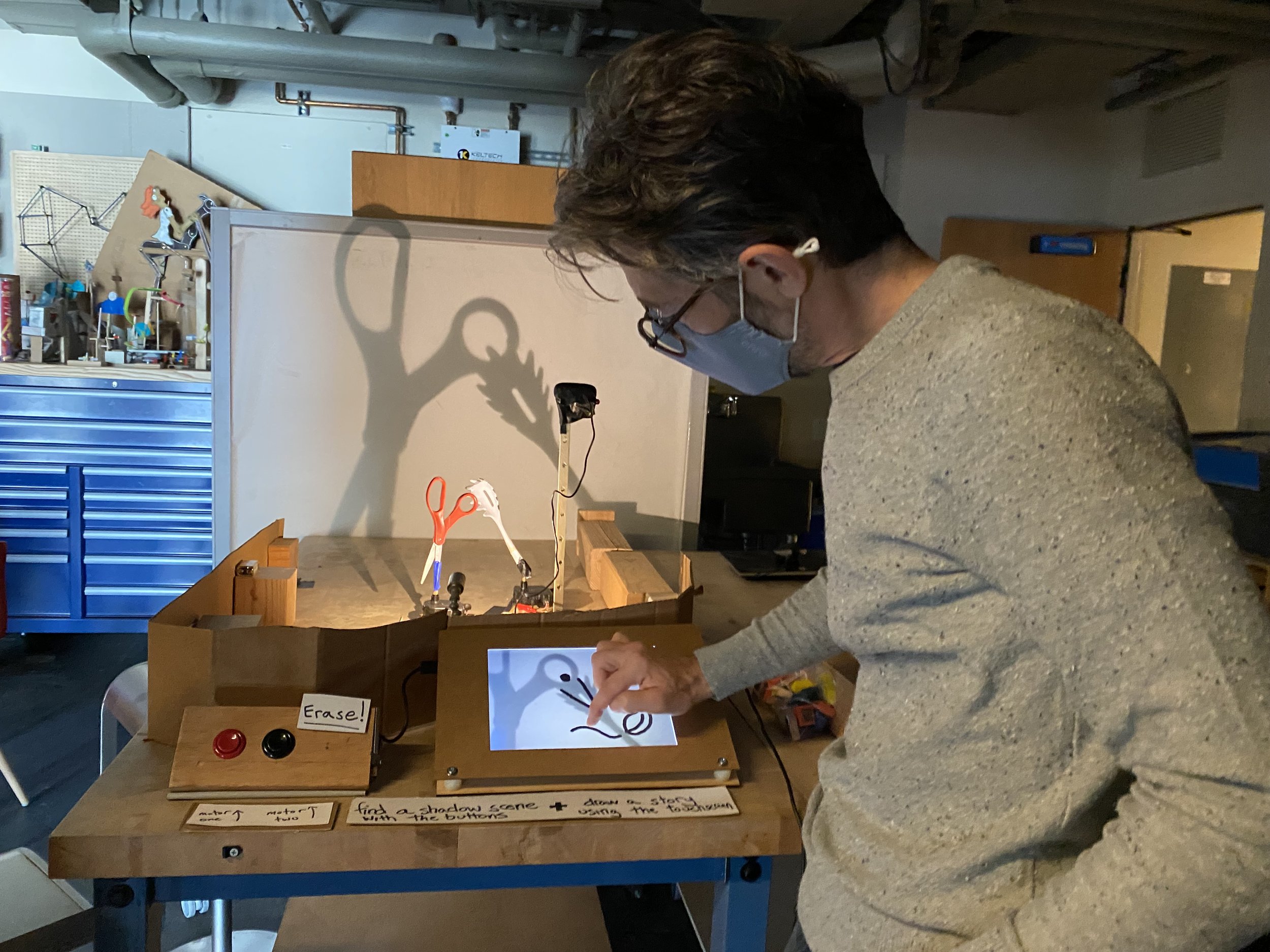Exploratorium Residency Week Four
Last week, I finished a month-long residency at the Exploratorium’s Tinkering Studio where I worked with a team of activity developers to prototype new tinkering experiences. We’re concentrating on designing ‘uftes’, which is what we’ve been calling tinkering experiences that don’t require a dedicated facilitator. The themes we’ve been exploring include balancing sculptures, sound automata, ramps/rollers and shadow remix. In this last week, we had more chances to test things out with visitors, build proof-of-concept designs in the workshop and share ideas with colleagues.
On Monday the 21st, the museum was open for holiday hours which gave us the chance to test out an activity with a steady stream of visitors to the Tinkering Studio space. We decided to set up a new iteration of balance with wooden bases, a clothespin-based building kit and colorful Calder-esque shapes for decoration.
It’s becoming clear that the unfacilitated tinkering experiences require environmental elements to support the interaction. For this balance activity we added signs on the bases, a video of examples, a materials table and a place to put finished projects.
It was really fun to see collaboration and teamwork from friends and families. Groups circled the stands making minute adjustments and noticing the changes in equilibrium.
One thing that was interesting was with a variety of starting point structures, there were challenges built into the materials set. A three pronged base was a bit more challenging than one with four dowels. Adding a little nub of a golf tee on the bottom of the sphere raised the center of gravity, making it harder to stabilize the structure.
The colorful shapes were attractive but we lost a bit of the story elements that we appreciated with the earlier kinetic creature prototypes. Some inspiration came from a visit from a group of young educators from the webstars program the next weekend who suggested connections to children’s books including one called “balance the birds”.
This led to another iteration of the design of the decorative elements and weights. We created a set of leaves and fruits to give the impression of creating stable and unstable tress and bushed. I think something along these lines might be really interesting because it encourages storytelling without limiting the investigation of the phenomenon. Maybe there can be even stronger ways of tying the design to the theme.
Another focus of the last week of the residency was developing a version of shadow remix that we could test on the museum floor with visitors. The experience is based on a online tinkering exploration where people find interesting shadows and add a layer of illustration on top to tell a personal story. We wanted to make a version that included the elements of closely observing shadows and sharing with others.
One of the ideas that we thought of is a digital app to do something similar to the markup function on an phone. Steph created a test program in Scratch using the video sensing and pen extensions that was good enough for our prototype. My computer doubles as a tablet with a touch screen function so I used that as the interface. The station also had two motors that could be rotated with buttons along with a physical switch to undo the drawing.
We brought out the set-up into a little dark space on the Exploratorium floor that normally hosts the sophisticated shadows exhibit and invited visitors to participate. The museum was pretty empty but we got a few visitors and a few explainers to test our prototype.
Something that we’d like to encourage in the ‘uftes’ is letting people can do things that are unexpected and based on their own ideas. One thing that I saw and liked along these lines was some of the explainers adding their hands and making their own shadows for the remix station. Even as we try to set clear entry points, we need to keep these moments possible.
Along with the digital version of shadow remix, Steph and Deanna have been working on a physical version of the experience that lets people play with magnetic shapes and re-interpet the shadows. They cut out a bunch of pieces of magnet sheet including eyes, hands, feet and colorful geometric shapes. We used a big white board for the surface and two pedestals for the lights and objects.
We also tried this with visitors and liked how collaborative it was and how it encouraged storytelling among groups. As we refine this idea and build an environment for tinkering, we’d like to add a video with examples, a way to capture images and think about how to invite people to participate in the activity.
On the last ‘official’ Friday of the residency, we had some time with all the colleagues of the Tinkering Studio and some guests from the exhibit shop to discuss our process of prototyping and to try out all four of the ‘uftes’ that we worked on this month.
It was so fun to see the group engaging with the explorations, asking questions and coming up with new ideas for the projects. Having time to play together with the physical materials is crucial for the development process as it brings more voices to the table and promotes conversation about the interactions.
Over the next two months I’ll be working remotely with the Tinkering Studio team, as well as with a group of external collaborators to go from our physical prototypes made with cardboard and hot-glue to more sturdy and engaging ‘ufte’ experiences that we can share with our network of partners in April and host in the Exploratorium this Summer!
The LEGO Playful Learning Museum Network initiative is made possible through generous support from the LEGO Group.

























